Gun Tests actively monitors reader mail for trends and requests for new test categories. Over the months, an area of particular interest has emerged: the AR-15. We are receiving numerous requests to test the new models and calibers that manufacturers have been bringing to market. There is also a huge number of accessories emerging in the marketplace, allowing customization to the modular design of the gun. As one gun expert aptly stated to us, “The AR platform has become the Swiss Army knife of firearms.”
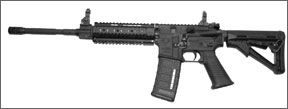
While all of these options are great for consumers, we do wind up peering into computer screens and thumbing through catalogs to sort through the dizzying array of products present in todays market. The options out there arent necessarily cheap; the AR-owner can easily have as much invested in accessories as he does in the rifle.
Because of this economic fact, we explored some options available in multi-position stocks for the AR. The six-position OEM stocks of AR-15 carbines have enjoyed an enduring love/hate relationship with their owners over the years-loved for their adjustability, yet cursed for their wobbly fit and slippery buttstocks.
Another issue has emerged as owners adopt new options in flip-up sights, and mount the latest in tactical optic technology from companies such as Aimpoint and Eotech. The low small rounded profile of the stock causes inconsistent cheek weld, and accordingly creates problems with sight alignment. This is a cause of frustration for the varmint hunter attempting to track a running coyote, but is a much bigger issue for the police officer in a confrontation, or a soldier clearing rooms in Iraq or Afghanistan.
Companies have introduced a variety of options to augment the shortcomings, or replace the stocks altogether, with varying degrees of success. In this article we will look at four such attempts.
For this test we selected four products: two attachable stock saddles for existing stocks, the Command Arms SST1, $26, and Cheaper Than Dirt #1543, $16. Both were plastic attachments that either snapped or screwed into place to provide additional cheek weld.
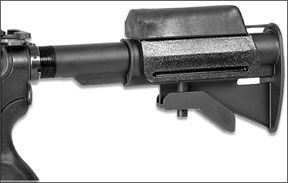
The two replacement stocks picked for this showdown were the Command Arms CBS, $61, fitted with an adjustable cheekpiece, $30, and Magpul CTR, $97, with its optional Rubber Butt Pad, $20. In this review, we found that $25 might be all you need to invest in order to cure your gunstock woes, but a $110 replacement would be our choice.
How We Tested
Immediately upon unpacking, each item was reviewed for its overall appearance. We looked carefully for any flaws in their construction, also scrutinizing the cosmetics, fit, finish, and overall build quality. All mounting hardware was examined, assembly directions read (more on that later), and then all parts were assembled where applicable. Each item was then installed on our Stag Arms platform gun.
Once mounted, adjustment levers, storage compartments, and other moveable (or removable) parts were then cycled through their functions to detect weak points, or inconsistent performance, and then documented accordingly.
We then ran each test item through a battery of action/tactical movements, including sighting and reloading with the stocks in a variety of locking positions, stock adjustment on the move, and some general roughhousing along the way. We attempted at every turn to coax some sort of mechanical failure from our candidates.
Afterward, all of the tests, results, and general comments were combined and reviewed for ranking, and recommendations. The compilation of our findings and subsequent Report Cards are as follows:
Cheaper Than Dirt
Cheekpiece #1543, $16
Proudly displaying a thoroughly Texan sense of humor in its name, Cheaper Than Dirt is a highly successful catalog and retail operation based in Fort Worth. Billing itself as “Americas Ultimate Shooting Sports Discounter,” CTD specializes in offering a variety of guns and military surplus items. The company also has a Buyers Club offering additional discounts for an annual fee.
While thumbing through CTDs latest catalog, we ran across the CTD-branded Cheek Rest for AR-15 Carbines #1543 (also listed as ARR-487). Priced for only $16, the item description states that “It will keep your eye level with your scope while ensuring a solid cheek weld. The soft rubber riser is easy on your cheek, lightweight.” While our platform rifle is not currently wearing a scope, an addition is planned, and a solid cheek weld helps all sighting chores. Although hardly expecting a world-class performance, we ordered one in hopes of finding a frugal solution to our aiming needs.
The 1543 arrived promptly, with the package showing no evidence of damage. We uncrated our prize to find a one piece assembly of
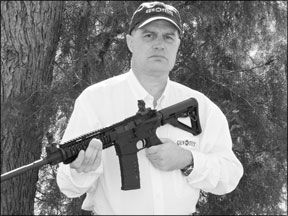
plastic & rubber. No mounting hardware was included, because the unit was designed to snap over the existing stock. Our apprehension began to grow when noticed the rectangular “soft rubber” cheekpiece wasnt all that soft, nor did it appear that well constructed. When we attempted to install the 1543, it promptly split into two pieces. No he-man pressure was applied.
A trip to CTDs website (www.CheaperThanDirt.com), informed us that we werent alone in our dilemma. The companys Customer Rating section showed similar complaints, and a low overall rating. Armed with this new information, we returned the offending product, and received a prompt refund.
Command Arms SST1
Stock Saddle, $26
Another, much more successful attempt at augmenting the OEM collapsible stock cheek weld issues comes from Command Arms Accessories, a large supplier of weapon accessories, and the sister company of Fobus holsters.
When our Model SST1 Stock Saddle arrived, we unboxed it to find it packaged in a Zip-loc-style bag. Unfortunately, it was missing two components: The instruction manual and one of the two caps intended to hold CR123A batteries in tubes located on each side of the saddle. The SST1 was a nicely textured piece of plastic, cleanly
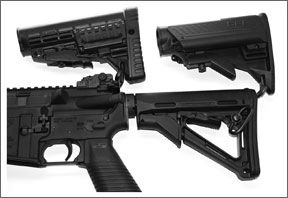
molded, and surprisingly sturdy. An embossed CAA was emblazoned on each side of the saddle.
We succeeded in mounting the SST1 to the OEM stock without the directions. Two plastic mounting blocks screwed together in the slot below the stock tube. The Stock Saddle then fastened securely to the blocks.
After assembly, the SST1 provided a significantly better feel and improved cheek weld as advertised. Our next step was to contact the CAA Customer Service line to get our missing battery cap. After a nice conversation, we were assured our problem would be solved. A few days later, a package showed up at our doorstep. Enclosed was another Stock Saddle, mounting hardware, but no battery caps!
Another phone call resulted in a smaller package showing up with the missing cap. We were told to keep the first shipment, so we would have some spare parts lying around.
We wish we could report that were completely happy with the SST1, after all the effort put forth to get it assembled. However,
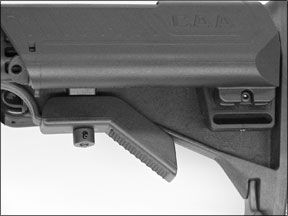
we found the battery caps had a tendency to work loose if one did not exercise considerable care installing them, dumping $10 worth of batteries in the process. We suggest using the string mounts to keep from losing the elusive caps, and checking them periodically if you choose to use them for battery storage.
The SST1 has rubberized twin, the SST2 for an MSRP of $30.
Command Arms CBS
6-Position Collapsible Stock,
$61 w/Optional ACP Cheek
Piece, $30
The CBS carries a recommendation from the National Tactical Officers Association (NTOA), so we eagerly awaited its arrival. The CBS arrived in another re-sealable bag, accompanied by the ACP, packaged in the same manner. Out of the bag, the Collapsible Stock shared a common trait with its cousin, the SST1-a missing installation manual.
All of the CBS standard design features were already screwed into place, namely a latched battery compartment and accessory rail for mounting options like the ACP, but the CBS bills itself as being ambidextrous, so we set about turning our stock southpaw, even without paperwork. We were able to do so with minimal effort, relocating a Picatinny rail panel, storage panel, hinge mount, latching plug, and six Phillips drive screws in the process. This speaks more to the refined design of the stock, than our manual dexterity.
The ACP refit proved trickier, only because the mounting screws were located inside the curvature of the molding. These were Allen heads and were furnished with a mounting wrench which made the
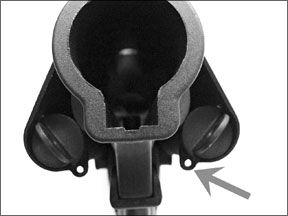
four screw exchange easier.
A review of the stocks appearance showed clean plastic molding, with smooth edges, a matte finish, with a slight sheen to it. The CBS was highly stylized, with two rows of oblong holes running the length of the stock, seeming to serve no real purpose other than to reinforce an aggressive evil black rifle aura. This pattern was continued on the latch door and buttstock.
Mounting the stock required a simple pull downward on the bottom-mounted lever, allowed the CBS to easily slide onto the rifle receiver. Once mounted, we continued our evaluation.
Several features immediately drew our attention, the first being an extremely ample molded rubber recoil pad. It was also notable for its non-slip texture, retaining its grip even on slick nylon fabric. Its extra thickness was overkill for the recoil of the 5.56mm, but may prove more valuable for some of the larger calibers like the 6.8mm SPC, now being built on the same Mil-Spec frame. Finger grooves were molded in the adjustment lever, and the stock moved up and
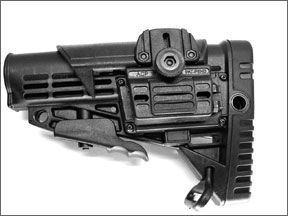
down the receiver freely, and quickly locked in place. We noticed the CBS still shared some of the characteristic wobble of the OEM stock.
We did not like the molded plastic sling mount. We dont want to trust our weapon to such a cheap feature and the rough plastic flashing on one corner didnt help our opinion. Fortunately there are two ultrasonically welded metal mounting studs located on the front and back of the stock, allowing the addition of an $8 PBSS Quick Detach Sling Swivel, which we consider money well spent.
One side of the stock was occupied by a battery compartment held shut by plastic-latched door. The plastic latch gave us some pause as to its durability, but it snapped together firmly and held the four CR123A batteries in place throughout our drills.
The other side of the stock held a Picatinny rail, which can be used to mount an MPS Magazine Pouch ($16), or the ACP.
The ACP features a latching mechanism, which when pulled upward, allows the cheek piece to slide on the rail, and lock in place. The Picatinny rail is long enough to allow some lateral adjustment of the mechanism. A sliding rail with a tightening knob
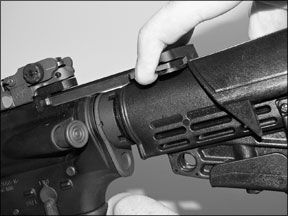
handles the up and down movement of the ACP. We found that we could move the device to a position of our liking, and have it stay there.
We did find one significant problem with the rig. When the stock was fully collapsed or in the first detent position, the hood of the ACP occasionally prevented the charging handle on our gun from fully extending, even though the ACP was in its flush position on the stock. Despite the flattened area on the top of the ACP, which was designed to accommodate the handle, there was enough play in the design to interfere with the charging operation. If one noticed the condition, the charging handle could be lifted over the obstruction.
Are we quibbling? Absolutely! The average user might never experience this, or think it a minor annoyance. However, someone exiting a cramped police cruiser or armored personnel carrier with
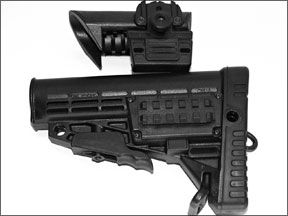
the stock fully collapsed, and their minds otherwise occupied, might be slightly more angry, or worse. We owe it to our readership to point out potential problems, no matter how small they may seem to some folks.
Operators whose jobs might include such actions should take care when using the stock, and may be better served without adding the ACP. Although not as comfortable without it, the CBS is somewhat wider than the OEM model, and does offer loads of features for the money.
Magpul CTR Mil-Spec
Carbine Stock, $97
w/Opt. Rubber Buttpad, $20
After reviewing the Command Arms CBS, the Magpul CTR seemed downright Spartan in comparison. Knowing the companys history, it seemed a wholly appropriate description.
Magpul was started several years ago by a former Marine, Richard Fitzpatrick. His first invention was a rubber device that fit on the bottom of a rifle magazine, making it easier to pull out of an ammo box. It also protected the magazine follower if dropped, and assisted in pulling a sticky magazine from a gun.

0)]Keeping things simple, since his attachment made pulling out magazines easier, he named his company Magpul.
Since that time his company has broadened its product offering to include other accessories, such as the CTR, utilizing the same school of thought in their product development.
Our sample arrived in a cardboard box emblazoned with the companys logo, which looks very similar to a biohazard symbol, and lo and behold, installation instructions!
After removing the CTR from the box, inspection revealed an unassuming, skeletonized frame. It was a consistent, clean dull matte black that matched our weapon exactly. All the surfaces were uniform, with no rough seams or inconsistencies. Magpul doesnt bother with a sling swivel, instead opting for a single ultrasonically welded metal insert to suit a QD swivel. The Command Arms PBSS fit nicely into it.
We moved straight to installation on our weapon, which required a

1)]little more effort than the other tested items. The optional Rubber Buttpad required us to pop off a small cover on the endplate, insert the Buttpad into the notched cover area, and insert two supplied screws. It is a relatively thin, but soft rubber, similar to that found on the Command Arms Model. It also has the same ability to hold tight on slick clothing.
Unlike other stocks, the CTR has a spring-loaded pin that must be pulled downward to allow the stock to be attached. The spring is quite strong, and requires us more delicate types to use a glove or towel to grip it securely, and pull it to a down position. The stock then snaps into position.
You will immediately notice a difference in the adjustment controls for the CTR. There are two levers rather than one. The first lever is located inside the triangular stock frame. It is a small paddle with finger ridges on it. This allows the positional adjustment of the stock. Its protected location prevents it from being accidentally knocked out of place.
The second, larger lever controls a friction plate device. When it is depressed, it locks the stock down tight. Zero movement, no

2)]wobble, no noise. This lever snaps out of place when the smaller lever is depressed, allowing the stock to be repositioned. It is a simple, strong, ingenious design.
The stock shows the same well executed subtlety. Instead of being rounded, the CTR has two flattened areas on the comb of the stock. This creates more surface area for a solid cheek weld, without broadening its slim frame.
Interestingly enough, Magpul does have snap-on risers for the CTR, but specifically does not recommend them for AR-15 style firearms for the exact issue we encountered with the Command Arms ACP.
The Magpul CTR is a lightweight, efficient, effective design that proves that the simplest answer is often the best one. Our only complaint is the price we paid for their ingenuity.
The CTR is also available for commercial, non-Mil Spec rifle tubes carrying an MSRP of $117.



























